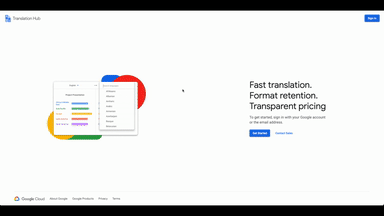
Translation Hub is a self-serve document translation service for organizations that translate a large volume of documents into many different languages. Translation Hub is a fully-managed solution; you don't need to build or maintain your own web application or underlying infrastructure.
After the initial setup, you can start using Translation Hub to quickly translate documents with simple, page-based pricing. Translation Hub machine translates your documents while preserving their format and layout.
Translation Hub leverages the Cloud Translation API. Any resources that you created with Cloud Translation can be used with Translation Hub, such as glossaries and custom translation models.
How does Translation Hub work?
Authorized business users (also known as portal users) sign in and request translations through a Translation Hub portal. These portal users might be localization managers or content creators who want to rapidly translate documents.
Portals are a Translation Hub resource and are managed by a Google Cloud administrator in a Google Cloud project. To grant users access to portals, administrators add them to their Google Cloud project and assign them to portals. Portal users can only access their assigned portals; they can't access the related Google Cloud project.
Benefits
The following benefits highlight how Translation Hub can improve the overall efficiency of your translation workloads:
- Self-serve translation
- Compared to traditional Translation Management Systems, which are process heavy and start with human translators, Translation Hub lets you use AI and then augment results with human translators. You start with machine translations and then, as part of a post-editing step, you can bring in your own human reviewers to review and edit the machine translations. By including both AI and human-editing capabilities, Translation Hub offers timely and cost-effective translations.
- Document translation
- You can directly translate documents such as PDF and DOCX files. Translation Hub preserves the layout and format of the original documents, such as paragraph breaks and headings. You don't need to extract and translate the raw text from your documents.
- Simplified administration
- Administrators can manage all Translation Hub resources from the Google Cloud console. For example, you can set up portals, manage user access, and create translation resources like glossaries and translation memories.
- Continuous increase in accuracy
- During post-editing, you can save edited translations to a translation memory. A translation memory saves your human-edited translations so that they can be reused later. You can also import existing translations into your translation memory.
- Your translation memory data is owned by you and remains with you. If you want to take your data, you can export it to Cloud Storage and use it, for example, as training data to create custom models.
- Straightforward page-based pricing
- Translation Hub charges you based on the number of translated pages. For example, if you use custom models and translation memories, there is no additional cost. Those features are included in the per page translation costs. However, any costs that are associated with model training are charged separately by Cloud Translation.
Sample use case
Imagine that you are in an organization that offers various time-sensitive reports to customers all over the world. Because you have readers across many different languages, you require a translation service that can quickly turnaround translations and handle many different documents.
Translation Hub provides self-service document translation to over 100 languages with a simple, cost-effective page-based pricing. Because Translation Hub is self-service, you run translations when you're ready and the results are returned a few seconds later. You can repeat these workloads consistently with many different documents in any of the supported languages.
You can also bring in your own reviewers to refine translations (also known as post-editing). You can save post-edits to a translation memory to improve the accuracy of future translations. Later on when you have enough sentence pairs, you can export your translation memory data to train custom models in Cloud Translation. Compared to the default translation model, a custom model can improve machine translations for your domain-specific content.
Pricing tiers
Translation Hub offers a basic and advanced pricing tier for each portal. The advanced tier offers additional features at a different translation cost per page. Administrators set the tier when they create a portal. For more information, see Compare basic and advanced tiers or Translation Hub pricing.
What's next
- For administrators, learn how to set up a project and enable translations.
- For portal users, learn how to request translations.
